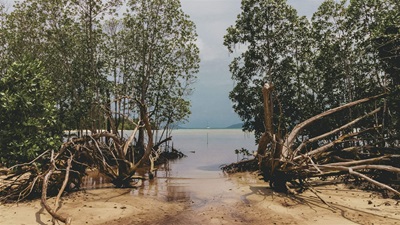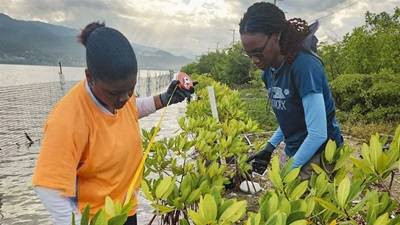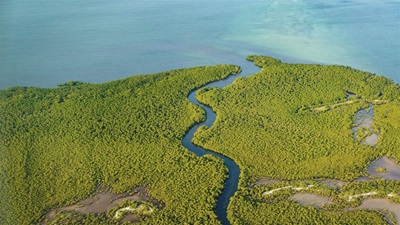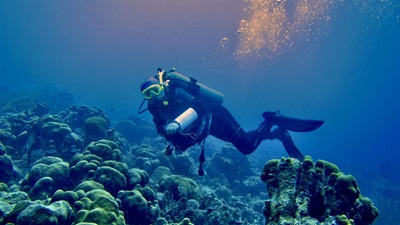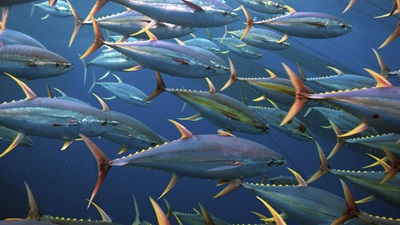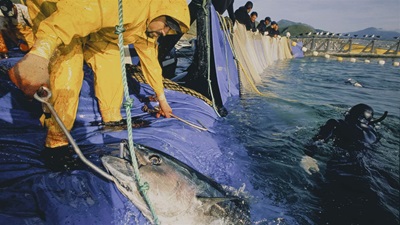Pew Launches New Key Partnership in Support of Coastal Wetland Conservation in the Caribbean
Events in Panama City connect science to policy in effort to further national climate goals

Editor’s note: This article was updated June 2, 2025, to clarify Pew’s partnership with The PROCARIBE+ Project, and that project’s role in Caribbean region marine conservation and economic development.
Coastal wetland ecosystems—mangroves, seagrasses, and salt marshes—provide countless benefits to coastal countries, including by buffering floods and storms, sequestering and storing large amounts of carbon, and serving as habitat for biodiversity. On average, these ecosystems sequester and store more carbon per hectare than terrestrial forests, which means that healthy coastal wetlands are nature-based solutions that help governments mitigate the effects of climate change. They’re also the only three marine ecosystems with globally agreed upon methods—from the Intergovernmental Panel on Climate Change—to measure their ability to sequester and store carbon within their biomass and sediments.
Now governments have a timely opportunity to account for coastal wetlands’ climate adaptation and mitigation benefits in their nationally determined contributions (NDCs) to the Paris Agreement, the landmark 2015 climate deal. Every five years, parties must revise their NDCs to be more ambitious in order to contribute to achieving the Paris Agreement’s climate goals; the next round of NDCs are due in September.
To help governments in the wider Caribbean region with these NDC revisions, The Pew Charitable Trusts is partnering with the United Nations Development Program PROCARIBE+ Project, funded by the multilateral trust Global Environment Facility. The Project is executed by the United Nations Office for Project Services.
PROCARIBE+ seeks to protect, restore, and harness “the natural coastal and marine capital” of two United Nations-designated large marine ecosystems: the Caribbean Sea and the North Brazil Shelf, which traces nearly 2,500 miles of coast from eastern Venezuela to the Parnaiba River delta in Brazil. The term “natural coastal and marine capital” refers to the economic value that comes from coastal ecosystems and the services they provide to society, such as providing food resources, regulating the climate, and supporting coastal tourism economies. As a part of this effort, PROCARIBE+ is working to drive investments to foster a climate-resilient, sustainable economy. The partnership is also mapping Panama’s seagrass meadows and conducting a carbon stock assessment to support NDC implementation.
Pew has two main objectives as part of the PROCARIBE+ project, which were highlighted at the United Nations Framework Convention on Climate Change (UNFCCC) 2025 Climate Week in Panama City last week:
- Support the integration of marine and coastal natural capital in national-level climate change mitigation and adaptation commitments by countries in the region.
- Help generate data to enable sustainable financing for seagrass conservation in Panama.
Panama is a strong case study for how countries can include the climate benefits of coastal wetlands in their NDC revisions. Panama’s most recent NDC, for which Pew and partners provided mangrove research and policy support to the Panamanian government, included an array of ambitious commitments to conserve, restore, manage, and map coastal wetlands and peatlands, including:
- Fully mapping the extent of seagrass and coral reefs ecosystems, as well as updating and strengthening the country’s Wetlands Action Plan—a national strategy for conserving and managing wetlands—by 2027.
- Establishing a monitoring system for seagrass and coral reef ecosystems by 2028.
- Increasing and/or restoring 1,800 hectares of mangroves by 2028.
- Ensuring that at least 50% of the nation’s mangrove ecosystems are integrated into the country’s National System of Protected Areas (SINAP) by 2026. Additionally, Panama plans to evaluate and improve effective mangrove management at the national level by 2027, and if it raises the required additional financial support, the country plans to achieve the protection and effective management of at least 50% of the mangroves within SINAP by 2028.
- Mapping the extent of peatland ecosystems and conducting a first-time assessment of peatland carbon stocks within Panama by 2027.
- Completing an update, by 2030, of the country’s national wetland inventory with a focus on coastal wetlands, an update that will include an evaluation of wetlands’ biodiversity and the benefits that they provide to people.
To kick off the 2025 UNFCCC Climate Week in Panama, Pew hosted a workshop for representatives of regional governments, nonprofit organizations, and the private sector, featuring best practices and key lessons from countries in the region, including Panama. Countries in which Pew has partnerships—including Jamaica and Honduras—are developing their NDCs to include coastal wetlands, and the workshop was designed so that they could learn from regional counterparts who have navigated the process before.
At Climate Week, Pew also advanced plans to help Panama in implementing the NDC commitment to fully map seagrass ecosystems in the country’s waters by 2027. As part of the PROCARIBE+ project and in close collaboration with Panama’s Ministry of Environment and research partners, Pew will support a series of research activities on seagrass extent and carbon stock analysis on Panama’s Caribbean coast.
This work aims not only to help Panama meet its commitments to the Paris Agreement but also to gather baseline information to enable sustainable financing for seagrass conservation.
The Climate Week activities, part of Pew’s partnership with PROCARIBE+, aimed to advance coastal wetland conservation policy in the Caribbean and to help produce the science needed to support and implement national climate policies.
Anelise Zimmer and Kate Meyer are officers with The Pew Charitable Trusts’ advancing coastal wetlands conservation project.



